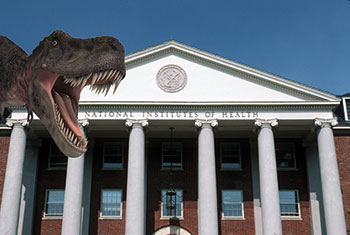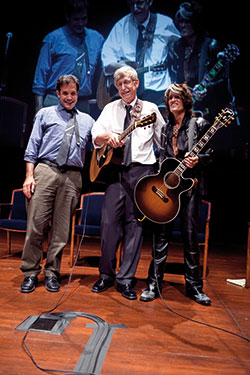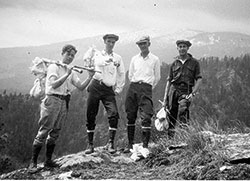Dinosaur or Biomedical Powerhouse?
US: The NIH
Career strategies for young European scientists
by Ralf Schreck, Labtimes 03/2012
The National Institutes of Health is at the very top in biomedical and health-related research with respect to available funds, its workforce and the size of its Clinical Center. More than 1,000 foreign researchers and clinicians join the NIH each year and contribute their share to driving scientific progress.
Biomedical research in the USA is a $100 billion plus undertaking. Two-thirds of all expenses are on the business sector including globally operating biopharmaceutical companies. The US Government or, to be more precise, the US taxpayer takes care of almost another third, primarily via the National Institutes of Health (NIH) annual $31 billion budget.
The NIH is the major US agency in charge of biomedical and health-related research and operates under the US Department of Health and Human Services. The Intramural Research Program of the NIH encompasses 23 out of the 27 NIH Institutes and Centers (ICs) and involves about 1,200 principal investigators, 4,000 postdocs and 1,000 students. The Clinical Center is doing patient-oriented research and does not offer the services of community hospitals to the general public. Each year, 10,000 new patients are enrolled and 1,500 active clinical protocols are pursued.
As a routine PubMed/Medline user, you may be aware that the 22-million record database is maintained by the National Library of Medicine, an institute of the NIH. The Extramural Research Program is providing competitive grants to scientists at universities and other research institutions outside the NIH. Close to 10,000 new grants each year and about 44,000 ongoing research grants in total drive biomedical and clinical research in the US.
Over the last 50 years, 80% of the Nobel Prizes in Physiology/Medicine were awarded or shared by scientists supported by the NIH. Since 2009, the NIH has been headed by Francis Collins, who is well known for his accomplishments as disease gene hunter and as leader of the Human Genome Project. Here, Lab Times will provide some insights on the NIH structure and funding programmes as well as on career pathways for the research talent from abroad.
NIH basics
The NIH mission is to “seek fundamental knowledge about the nature and behavior of living systems and the application of that knowledge to enhance health, lengthen life, and reduce the burdens of illness and disability”. The NIH argues that US citizens are indeed living a longer, healthier and more productive life thanks to its continuous efforts. This is substantiated by a 70% reduction in the death rate for coronary diseases and strokes over the last 50 years as well as 150 approved drugs and vaccines, which have been discovered by public sector research between 1990 and 2007. More than 1.35 million deaths per year are prevented by research advances claimed by the NIH.
Outside the US, the NIH is quite often in the news – not for its accomplishments but because of the annual skirmish over looming budget cuts. The whole 18-month budgetary process is quite tedious, not easy to figure out and sometimes bears nasty surprises for scientists, who had expected a windfall and then have to realise that funding streams have been diverted at the last second.
The $30 billion NIH budget is under constant surveillance by various patient advocate groups, which would like more funds to be allocated to the disease condition for which they are lobbying. Moreover, in face of the public US debt rapidly approaching $16 trillion, many US citizens disagree with the view that the promise of biomedical research alone can acceptably justify these investments. As a federal agency, the NIH has to document all expenses and activities. RePort, the Research Portfolio Online Reporting Tools, allow one to sift through millions of data and documents: from the number of NIH employees, over the composition of the scientific workforce and the success rates of grant applications to the individual research grant, where the principal investigator and the size of his grant is listed. In contrast to many other large, funding organisations from abroad, where it takes several weeks and numerous emails and calls to get meagre responses, one is already buried in the online information provided by the NIH.
The research output
The Research, Condition, and Disease Categorization (RCDC) system, introduced in 2008, allows the analysis of NIH-funded projects and the flow of funds into 233 particular disease and research areas. According to RCDC, cancer with $5.5 billion as well as infectious diseases and brain disorders with almost $4 billion each received most funds last year. With respect to research areas, genetics ($7.2 bn) and biotechnology ($5.8 bn) stick out the most, while prevention was supported by $6 bn and clinical trials with $3 bn. Overall, the ratio of funds spent for basic biomedical versus applied research is 54:46.
However, when the organisations were ranked according to other indicators, a different picture emerged. The National Institutes of Health made it only to position 25 in the category “10 % of most cited papers”, and its performance in relation to the world average hardly took it among the top 50. This might reflect the pressure for NIH scientists to produce a continuous stream of at least average publications in order to advance in their careers or to keep their research budget. It is quite difficult to judge whether there is indeed an effective use of research funds at the NIH or to imagine how biomedical research in the US would perform without the NIH.
The early beginnings
The NIH story began in 1887, when the Laboratory of Hygiene was established by the physician Joseph Kinyoun on Staten Island, New York. Kinyoun was an employee of the Marine Hospital Service (MHS), which, at that time, was also in charge of screening arriving ship passengers for obvious symptoms of infectious diseases, such as smallpox or cholera. After Pasteur, Koch and others had provided evidence that certain diseases are caused by bacteria, the MHS decided to expand its diagnostic capabilities by establishing a bacteriological lab. Kinyoun used a Zeiss microscope to provide the first glimpse of Vibrio cholerae in the US. In 1891, his lab was moved to Washington, DC. When Kinyoun detected the bubonic plague in San Francisco in 1899, he refused to keep quiet. To avoid political and financial damages he was accused of deliberately importing plague cultures to California and was forced to resign.
The MHS was changed to Public Health and Marine Hospital Service in 1902, into Public Health Service in 1912 and, finally, by the 1930 Ransdell Act into the National Institutes of Health. More important than name changes was the increase of governmental support for the NIH. The War on Cancer, the HIV/AIDS epidemics or the ambition to become a global leader in biomedical research were used to justify the step-ups. The NIH budget passed $1 million in 1943, $10 million in 1948, $100 million in 1957, $1 billion in 1966, $10 billion in 1993, $20 billion in 2001 and $30 million in 2009. The money has enabled the stepwise establishment of several NIH ICs and increased support to the scientific community inside and outside the NIH. The National Cancer Institute (NCI) was the first NIH Institute to be built in 1937, whereas the Center for Scientific Review was the first NIH centre to be opened in 1946.
Intramural high-risk research
To fulfil its mission, the NIH operates as research performer, funding organisation and provider of training for scientists and physician-investigators. The NIH has a workforce of about 19,000. Among them are 6,000 scientists conducting research in frame of the NIH Intramural Research Program (IRP). Since only 500 students are working towards a doctoral degree, the 4,000 or so postdoctoral trainees may be considered as the real “workhorses” of the NIH.
Emphasis is placed on high-risk and high-reward research, which is supported by roughly $3 billion or a tenth of the whole NIH budget. Key elements are intellectual freedom, quite stable resources and funding mechanisms, a critical mass of talent for collaboration and support for unconventional ideas. The majority of the 27 independent NIH ICs are located on the 130-hectare campus in Bethesda, Maryland. But a few NIH facilities are also found at more distant locations, such as the National Institute of Environmental Health Sciences in Research Triangle Park, North Carolina, or the Rocky Mountain Labs in Hamilton, Montana.
Making the most out of its money
Each IC has its own ways of distributing the money that is allocated from the central NIH budget. The Intramural Research SourceBook provides a good overview on all aspects related to research. Although some content is for NIH employees only, you may learn a lot about research programmes at individual ICs, about personnel policies including visa and permanent residency requirements and the NIH tenure-track programme. In times of limited funding, a website termed “Intramural Dollars Stretching” invites recommendations on cost savings that allow the NIH to make the most out of its money.
Interactions between different ICs have a long tradition and go beyond the sharing of core facilities. More than 125 active Scientific Interest Groups focus on specific scientific or research-related topics and bring together not only scientists from different ICs but also extramurally-funded scientists. The NIH Common Fund was enacted in 2006 to support cross-cutting, trans-NIH programmes that require participation of at least two different NIH ICs.
The Common Fund’s $550 million budget supports five to ten-year programmes that should function as catalysts, for example, by opening new research fields or by developing novel technologies and valuable resources. Examples include the Knock-out Mouse Phenotyping Program KOMP2 or the launch of the NIH Center for Regenerative Medicine. The Clinical and Translational Science Awards (CTSA) programme supporting a national consortium of medical research institutions was initially set up by the Common Fund, too but has recently been integrated into NCATS, the National Center for Advancing Translational Sciences. NCATS was officially established in 2012 with the mission to accelerate the development of novel diagnostics and therapeutics. The individual researcher is targeted by four Common Fund measures: the NIH Director’s Pioneer, the New Innovator and Early Independence Awards as well as the Transformative Research Projects. The Early Independence Award supports, for example, outstanding junior scientists wishing to skip postdoctoral training and start immediately with independent research. The first ten awards were made last year and provide support for a five-year period with up to $250,000 in direct costs per year. There is no citizenship or residency requirement for this award, which is open for scientists inside and outside the NIH.
NIH careers
There are all sorts of temporary and permanent scientific positions at the NIH, which may also be open to non-US citizens, depending on the type of position. The Division of International Services (DIS) provides in-depth information on the NIH Visiting Program, which provides opportunities to non-US citizen scientists for training or collaborative research. More than 3,000 researchers from over 100 countries seize this opportunity, currently.
There are two major categories: Visiting Fellows and Visiting Scientists. Fellows receive a monthly stipend for research training, whereas scientists receive a monthly salary including benefits. In order to participate you need a senior NIH investigator as supervisor or sponsor and a valid visa. Most foreign postdocs have either J-1 (exchange visitor) or H-1B (temporary visiting scientist in a speciality occupation) visas. Visiting Fellows must have a doctoral degree and no more than five years of postdoctoral research experience. Fellows are considered for “research training” and are not NIH employees. The rate of a Fellow's monthly living allowance is determined by the number of years spent as a postdoc in a research lab. In 2011, the entry-level stipend was $44,000.
Visiting Scientists receive a monthly salary and have employee status. They conduct health-related research and receive benefits available to US Federal employees. They must have three or more years of postdoctoral experience. Initial appointments are made for up to two years, which are renewable for up to five years. The following types of appointments are possible and a VP for Visiting Program is added in parentheses to indicate your status: Research Fellow, Clinical Fellow, Staff Scientist, Staff Clinician, Investigator and Senior Investigator.
Foreign Researchers
DIS provides an annual report on the international community at the NIH. In the 2011 report, 3,566 foreign nationals with 1,086 new arrivals were listed. Among them were about 1,900 Visiting Fellows and 575 Research Fellows. Most of the fellows were attracted to the National Cancer Institute (991), followed by the National Institute of Allergy and Infectious Diseases (413). Almost 60% of foreigners were from the South or the Far East and about a quarter from Europe.
At the more advanced level (Senior Investigator, Senior Research Fellow and Senior Scientist) only 12 scientists from abroad were listed.
Postdocs from abroad are asked to approach the principal investigator of interest at the NIH directly and to discuss funding and employment opportunities with him. The former central NIH application system for postdocs no longer exists. The NIH Postdoc handbook is quite a useful resource for postdocs coming to the NIH. The Fellows Committee FELCOM (http://felcom.od.nih.gov) represents the interests of postdocs by providing career development seminars, serving as intermediary to the NIH administration and jolting the communication among fellows.
Another starting point to get valuable advice is the Office of Intramural Training and Education (OITE, https://www.training.nih.gov/home).
Postdocs are generally appointed by three mechanisms, as Intramural Research Training Awardees (IRTAs)/Cancer Research Training Awardees (CRTAs), as Visiting Fellows (VFs) or as Research/Clinical Fellows under Title 42 (Federal employees). Postdoctoral stays at the NIH usually follow the 5/8 Year Rule. Initial appointments are for a period of one to three years, which may be extended to up to five years. In case of a promotion to Research Fellow, you may spend a total of eight years at the NIH. Remaining at the NIH beyond eight years requires approval for a tenure-track, tenured, staff scientist/clinician, or other staff appointment. Tenure at the NIH may be achieved in six years (or eight years, if engaged in clinical or epidemiological research) on a tenure-track position. If tenure is denied, the candidate will be permitted at least one terminal year. Up to 30 tenured or tenure-track positions are filled by the NIH each year.
Several opportunities for foreign postdocs are in place, which finance their integration abroad once the job at the NIH is done. For example, NIH International Research Career Transition Awards are available for several nationalities. In frame of these programmes a two to three-year postdoctoral stay at an NIH IC is paid by the NIH, whereas upon return to the home country a national funding organisation is expected to finance an independent research position for a couple of years.
The Fogarty International Center of the NIH also promotes the re-entry of NIH-trained researchers into their home country. In frame of the Global Research Initiative Program for New Foreign Investigators (GRIP) $50,000 indirect costs are made available for up to five years to support a scientist that completed at least two years of postdoctoral training at the NIH. Nationals from low and middle income countries are eligible.
Extramural grants
Almost each IC at the NIH is also in charge of funding external research within the frame of its own research activities and disease areas. The Extramural Research Program (ERP) targets biomedical research performed at non-NIH institutions, not only in the US but also worldwide. More than 300,000 scientists are supported at 2,500 institutions each year. About 80% of the whole annual NIH budget is used to fund these extramural activities and is distributed primarily via close to 50,000 competitive grants. Rock Talk, the moderated blog by Sally Rockey, the NIH’s Deputy Director for Extramural Research, is in place for communication with the scientific community outside the NIH. It provides the NIH perspective on diverse topics and tries to demolish some of the many myths about the NIH.
The NIH uses activity codes for the vast number of different funding programmes. Main types encompass Institutional Training Grants and Fellowships (T&F series), Career Development Awards (K series), Research Grants (R series) and Program Projects/Center Grants (P series). Not all types of grants are funded by each IC and eligibility criteria, funding limits, submission deadlines and other features may vary for the same programme from institute to institute. Funding Opportunity Announcements or FOAs provide the details of specific grants and are available under www.grants.nih.gov.
The most commonly used NIH research grant is the R01. The R01 is the bread-and-butter grant for biomedical researchers in the US and serves as a sensor for the whole US research funding system: applicant numbers, success rates of first time, new and established applicants and average costs are carefully monitored. Roughly $10 billion or a third of the whole NIH budget was used last year to support more than 25,000 R01 grants.
R01 is used to support an investigator-initiated research project, which is generally awarded for three to five years. There is no budget limit. Applicant numbers for the R01 are steadily on the rise but the opposite is true for the success rate, which is currently below 20%. Average costs for a R01 grant increased from $250,000 in 1999 to more than $400,000 in 2011. But if the 2011 average is adjusted to the 1999 price index, no large differences are notable. There are three application deadlines per year for new grants and also three deadlines for renewals and re-submissions. Other programmes from the R-Series include the NIH Small Grant Program R03 or the NIH Pathway to Independence Award-Research Phase R00.
There are eight different K awards for scientists with a research doctorate and nine different K awards for those with a health-professional doctorate. K awards are NIH career development awards for late-stage postdocs and younger independent investigators. Some awards are also foreseen for more established scientists, who, for example, move into a new research field. To make things even more complicated, the individual K awards greatly vary between the various ICs. Just to name a few: the Career Transition Award K22, the Mentored Research Scientist Development Award K01 and the Independent Scientist Award K02. Overall, about 900 out of 2,850 K applications were funded in 2011 and supported with $143 million. In addition, 600 postdoctoral fellowships (F32, rate 26.2%), 374 Institutional Training Grants (T32, T34, T35, rate 48%) and 1,227 Fellowships (F series, rate 29.4%) received funding in the last year.
The legendary study sections
Many myths and rumours are in circulation about the peer review process at the NIH. The review process has been under fire for its length, the lack of transparency, undue preference for established scientists and scientists using conventional approaches or for racial bias, since the Center for Scientific Review (CSR) of the NIH was established. Several changes for the better have been introduced over the last years such as a new scoring system, shortened applications, the restriction to only one resubmission and a combined review of proposals made by early stage and new investigators.
The CSR nowadays deals with roughly three quarters of all applications made to the NIH, whereas the rest is evaluated by individual ICs. In 2010, about 61,100 applications were reviewed with the help of 18,000 external experts. The experts are organised as permanent members or temporary reviewers into Scientific Review Groups, which are far better known as study sections. Each study section has 20 or more permanent members and meets two or three times a year in person or virtually to discuss about 50 to 120 applications per meeting. Special study sections for evaluating fellowships and small business applications do exist. A video of a study section meeting is accessible via http://public.csr.nih.gov. Several study groups are clustered into larger integrated review groups focusing on a broader topic such as “AIDS and Related Research” or “Cell Biology”.
When an application is made, a CSR Referral Officer first examines the application and determines the most appropriate review group and the IC, which is best-suited to fund the proposal once it gets approved. Each application is assigned to a Scientific Review Officer (SRO), who tries to find the best reviewers and accompanies the review process. Usually, two or more reviewers are selected and two of them have to provide a detailed written report on the application. Core criteria for evaluation encompass significance, investigators, innovation, approach and environment.
Anonymous scores
Each application is given a preliminary impact score from one (exceptional, almost no weaknesses) to nine (poor, almost no strengths). At the review meeting only the promising applications in the upper half are discussed, whereas the rest is returned for improvement. Preliminary scores are discussed at the meeting and, finally, all meeting members score anonymously, irrespective of whether they have read the proposal or not. The score and the written reports are transmitted to the applicant as well as to the NIH Institute or Center in charge, where another round of peer review is conducted by Advisory Councils or Advisory Boards. In the end, the score, the funding priorities of the individual IC and its available budget determine whether a proposal is funded. The Director of the NIH Institute or Center in charge makes the final funding decision.
Another level of review was recently released in the NIH budget proposal for 2013. All principal investigators who have already received more than $1.5 million in NIH support have to be reviewed, in future, by external experts before new grants are allocated. A Nature News article from 20 February 2012 entitled “Extra scrutiny for ‘grandee grantees’” revealed that several US researchers were funded by not less than seven NIH grants active in 2011. The group was headed by Ronald Davis from Stanford University, who had $7 million at his disposal. Overall, it is estimated that 1,500 scientists in the US are above the $1.5 million threshold.
Outlook
If you want to pursue your career in the States, the NIH is offering lots of possibilities. The chances of being supported by your hosting investigator or by a NIH fellowship are quite high and predictable. If there are no possibilities from NIH sources, you may still take advantage of fellowships for out-going scientists from your home country or of international fellowships. State-of-the art core facilities and a more than appropriate infrastructure are available to reach your research goals. You may benefit from the topic- or disease-specific interest groups, which bring together a critical mass of intramural and extramural experts at the forefront of scientific research. Further budget cuts, salary caps and frozen fellowship rates are foreseeable; however, they may not have a major impact on your own research project. Research at the NIH is postdoc-driven and about 60% of all postdocs are neither US citizens nor are they permanent residents. Being together with a large crowd of scientists at the same level in a multicultural environment will certainly pay off or, at least, be an interesting experience.
Internet Resources
Last Changed: 13.07.2012









